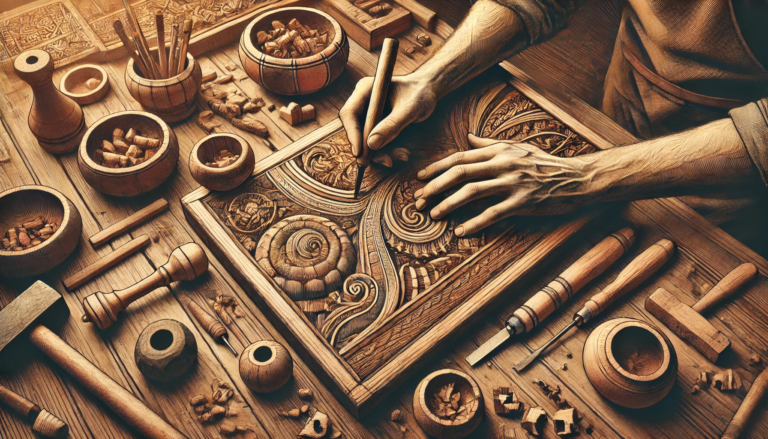In a world increasingly dominated by mass-produced items, wooden craftsmanship stands as a testament to human creativity, skill, and tradition. The art of creating wooden handicrafts has been passed down through generations, preserving techniques and designs that have stood the test of time. These handcrafted pieces are not only functional but also serve as unique works of art that add warmth, character, and a touch of history to any space.
In this blog, we will explore the beauty and significance of wooden craftsmanship, delve into the various types of wooden handicrafts, and discuss how these timeless pieces can be incorporated into modern interiors to create a blend of tradition and contemporary style.
The Essence of Wooden Craftsmanship
1. A Legacy of Skill and Tradition
Wooden craftsmanship is an ancient art form that dates back thousands of years. From the intricate carvings found in ancient temples to the simple yet elegant wooden bowls used in everyday life, wood has been a fundamental material for artisans around the world. The skill involved in crafting wooden items is passed down through generations, with each artisan adding their own touch to the craft while preserving the essence of traditional techniques.
The process of creating wooden handicrafts often begins with selecting the right type of wood. Different woods offer different characteristics in terms of grain, texture, and color, each contributing to the uniqueness of the final product. Artisans carefully consider these factors, along with the intended function of the piece, to create items that are not only beautiful but also durable and practical.
2. The Beauty of Handcrafted Wood
One of the most compelling aspects of wooden craft is the natural beauty of the material itself. Wood carries a warmth and richness that few other materials can match. The grain patterns, knots, and natural imperfections in the wood add character and individuality to each piece, ensuring that no two items are exactly alike.
Handcrafted wooden items often feature intricate details that highlight the artisan’s skill. Whether it’s the delicate carving of a decorative sculpture, the smooth curves of a wooden bowl, or the precise joinery of a piece of furniture, the craftsmanship involved in creating these items is a true art form. This attention to detail and the time invested in each piece are what make wooden handicrafts so special.
3. Sustainability and Timelessness
In today’s world, where sustainability is becoming increasingly important, wooden handicrafts offer an eco-friendly alternative to mass-produced, disposable items. Wood is a renewable resource, and many artisans take care to source their materials from sustainably managed forests. Additionally, the durability of wooden items means they can last for generations, reducing the need for constant replacements.
Wooden craftsmanship also carries a timeless quality. Unlike trends that come and go, wooden handicrafts have a classic appeal that never goes out of style. Whether you’re decorating a modern apartment or a traditional home, wooden pieces can seamlessly blend into any environment, adding a touch of nature and history to the space.
Types of Wooden Handicrafts
1. Decorative Wooden Carvings
One of the most popular forms of wooden craftsmanship is decorative carving. Artisans use a variety of tools to carve intricate designs into wood, creating everything from small figurines to large wall panels. These carvings often depict scenes from nature, religious motifs, or abstract patterns, showcasing the versatility of wood as a medium for artistic expression.
Decorative wooden carvings can be used to enhance the aesthetic of any room. For example, a carved wooden panel can serve as a stunning focal point in a living room, while smaller carvings can be placed on shelves or tables to add a touch of elegance and craftsmanship.
2. Handcrafted Wooden Furniture
Wooden furniture is perhaps the most practical and widely appreciated form of wooden craft. From tables and chairs to cabinets and beds, wooden furniture combines functionality with beauty. Handcrafted furniture pieces are often made using traditional joinery techniques, such as mortise and tenon or dovetail joints, which provide strength and durability without the need for nails or screws.
The beauty of handcrafted wooden furniture lies in its ability to age gracefully. Over time, the wood develops a patina that enhances its character, making it a cherished piece that can be passed down through generations. Whether it’s a rustic farmhouse table or a sleek, modern chair, wooden furniture adds a timeless quality to any home.
3. Wooden Kitchenware
Wooden kitchenware is another area where craftsmanship shines. Items such as cutting boards, bowls, spoons, and trays are often handcrafted from hardwoods like maple, walnut, or cherry, which are known for their durability and resistance to wear. These items are not only functional but also bring a natural, rustic charm to the kitchen.
Handcrafted wooden kitchenware is often preferred by those who appreciate the tactile quality of wood and its ability to age beautifully. Unlike plastic or metal alternatives, wooden utensils and kitchenware develop a unique character over time, with each use adding to their history and charm.
4. Wooden Toys and Games
Wooden toys and games have been cherished for generations. From simple blocks and puzzles to more complex mechanical toys, wooden playthings are known for their durability and timeless appeal. Many wooden toys are handcrafted by skilled artisans who take pride in creating items that are both safe and engaging for children.
In recent years, there has been a resurgence of interest in wooden toys, as parents seek alternatives to plastic toys that are often less durable and environmentally friendly. Wooden toys not only provide endless hours of imaginative play but also serve as beautiful keepsakes that can be passed down from one generation to the next.
5. Wooden Home Accessories
Beyond furniture and kitchenware, wooden craftsmanship extends to a wide range of home accessories, including picture frames, candle holders, jewelry boxes, and more. These items add a touch of natural elegance to any room and can be easily incorporated into various design styles, from rustic to modern.
Handcrafted wooden accessories are often made with attention to detail, ensuring that each piece is not only functional but also aesthetically pleasing. For example, a hand-carved wooden jewelry box can serve as both a practical storage solution and a decorative piece that adds warmth to a bedroom or dressing area.
Incorporating Wooden Handicrafts into Modern Interiors
1. Blending Tradition with Contemporary Design
One of the greatest advantages of wooden handicrafts is their ability to blend seamlessly with both traditional and contemporary interiors. Whether your home features modern minimalist décor or a more eclectic style, wooden pieces can add warmth and texture to the space. For example, a sleek wooden coffee table can complement a minimalist living room, while a carved wooden mirror frame can add character to a modern entryway.
When incorporating wooden handicrafts into your home, consider the overall color palette and design theme. Natural wood tones can soften a space, making it feel more inviting and cozy. Additionally, mixing different types of wood and finishes can create a layered, dynamic look that adds depth and interest to your interior design.
2. Creating Focal Points with Wooden Art
Wooden handicrafts can also serve as striking focal points in a room. A large wooden carving or a piece of handcrafted furniture can draw the eye and set the tone for the entire space. For example, a hand-carved wooden headboard can become the centerpiece of a bedroom, while a sculptural wooden lamp can add an artistic touch to a living room.
To highlight the beauty of wooden craftsmanship, consider placing these pieces in areas where they can be easily seen and appreciated. Proper lighting can also enhance the natural grain and texture of the wood, making the craftsmanship stand out even more.
3. Mixing and Matching with Other Materials
Wooden handicrafts can be easily mixed and matched with other materials to create a balanced and harmonious interior. Pairing wood with metals, glass, or textiles can create interesting contrasts and complement the natural warmth of the wood. For example, a wooden dining table with metal legs can bring a modern industrial edge to a space, while wooden picture frames can soften the look of a gallery wall.
When combining different materials, it’s important to maintain a cohesive color scheme and design style. This ensures that the wooden pieces enhance the overall aesthetic rather than clashing with other elements in the room.
Conclusion
Wooden craftsmanship is a timeless art that continues to captivate and inspire. From intricate carvings to practical furniture, wooden handicrafts offer a unique blend of beauty, functionality, and tradition. By incorporating these handcrafted pieces into your home, you not only add warmth and character to your space but also celebrate the skill and creativity of artisans who have perfected their craft over generations.
Whether you’re looking to create a cozy, rustic atmosphere or add a touch of elegance to a modern interior, wooden handicrafts provide endless possibilities for enhancing your home with natural beauty and timeless style.




